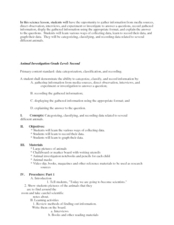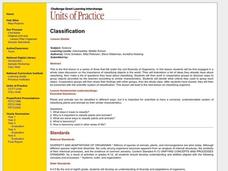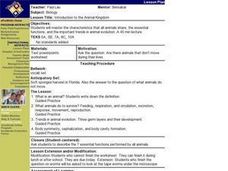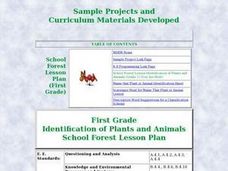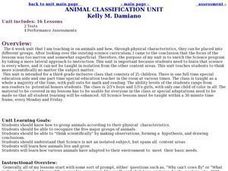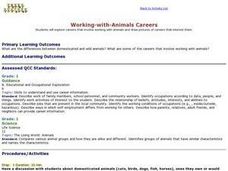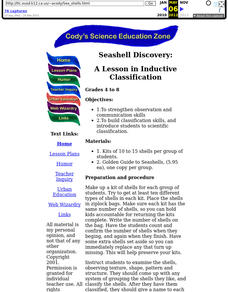Curated OER
Animals in the Wild
Students compare/contrast paintings with similar subjects and themes. They discuss how a painting may relate to life experiences. Students draw animal families and compose a story about a painting by Gerome. They discuss zoos and...
Curated OER
Animal Investigation
Third graders gather information and classify animals. In this animal investigation lesson, 3rd graders research animals, and organize the information into notebook.
Curated OER
Aquatic Safari
Students use an Internet Web site to locate the scientific information about various marine species. They use the Internet to find the scientific information about marine animals.
Curated OER
Seed Sensations!
First graders examine seeds. In this Science lesson, 1st graders classify and dissect seeds. Students sprout their own seeds in the classroom.
Curated OER
Classification
Students investigate how to classify items based on similar characteristics. They study the scientific system of classification.
Curated OER
Singing About Zoo Animals
Fifth graders sing a variation of "The Muffin Man" with lyrics dedicated to zoo animals. As a class, 5th graders sing the song as a round and maintain a stead beat and rhythm while singing.
Curated OER
Introduction to the Animal Kingdom
Students are asked: Are there animals that don't move during their lives. They are asked what is an animal? Students discuss what animals need to survive. They are taught the trends in animal evolution. Students discuss the three...
Curated OER
Classification of an Echinoderm
Students study starfish through dissection. In this biology lesson plan, students explore the lives of starfish as they view a slide show, observe parts of echinoderms, and compare the classification of the starfish with other...
Curated OER
Animals of Africa
Pupils identify animals indigenous to Africa, then create an imaginary animal using various materials they have at home. They write about their animal and include its name, characteristics, and describe how it defends itself.
Curated OER
City Animals
Students, in groups, conduct research, including interviews of people in various animal related occupations, to identify and describe how animal populations of cities have changed over time, to outline the benefits and problems...
Curated OER
Animal Symmetry and Phyla
In this animal kingdom worksheet, students complete a graphic organizer by writing in the phylum and body symmetry for the 12 animals listed.
Curated OER
Identification of Plants and Animals
First graders identify a variety of plants and animals that can be found in the school forest, then differentiate between plants and animals. They find examples of characteristics used to differentiate between plants or animals.
Curated OER
Animal Classification Unit
Third graders study how to group animals by their physical characteristics. They examine how animals have adapted to have their needs met by the environment.
Curated OER
What's a Mammal?
Students research his or her assigned mammal using print and online resources. In this mammals research lesson, students discover mammals have certain traits that distinguish them from animals in other classes, such as fish,...
Curated OER
Classifying Dog Breeds
Students classify dog breeds. In this animal science lesson plan, students research various breeds of dogs on the Internet and classify breeds into small, medium, and large breeds. Students illustrate their classification notes with...
Curated OER
Introduction To the Classification of Organisms
Students discuss how scientists classify organisms. In pairs, they analyze and label "specimens" of breakfast cereals in order to classify them into the correct group. They create a dichotomous key for several species of animals.
Alliance Theater
The Jungle Book Post-Show STEAM Lesson
An ecosystem is really just the flow of energy through many different living organisms. A study of Rudyard Kipling's The Jungle Book leads to an environmental science activity in which learners study how various factors can affect...
Curated OER
Animal Characteristics
Students investigate biology by completing a group classification activity. In this animal characteristics, students discuss the different families in the animal kingdom and the small differences that separate the animals. Students...
Curated OER
So You Think You're Tough
Fourth graders learn how to classify animals. In this invertebrates lesson, 4th graders discuss how we classify thinks into groups and move into a discussion about classifying animals. Students learn about the differences between...
Curated OER
Working-with-Animals Careers
First graders list and discuss careers that involve working with animals and draw pictures of careers that interest them. They compare and contrast domestic and wild animals.
Curated OER
Seashell Discovery: A Lesson in Inductive Classification
Young scholars examine the shells, observing texture, shape, pattern and structure. They should come up with any system of grouping the shells they like, and classify the shells.
Curated OER
Where Do I Go At Night?
Students describe the requirements of daytime and nightime animals for survival. They identify any behaviors that assist in the animal surviving. They create a representation for the class to view.
Captain Planet Foundation
Energy Flow in the Garden
How can you tell what an owl has eaten? Study the food chain and flow of energy in an ecosystem by dissecting an owl pellet and noting the bones found inside. Additionally, the lesson includes a game about consumers and producers with a...
Curated OER
Our Zoo Friends
First graders plan and create a model zoo depicting the natural habitats of animals. Their models include animals and a display of written factual information about the animals. Students present their project by conductig a tour of...

